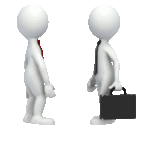Business Etiquette ~ The Beginning, End, and a Common Error
 I was curious about changes in business etiquette. So, I looked at a Business Insider article, which excerpts fifteen points made by Barbara Pachter in her new book “The Essentials of Business Etiquette.” Let’s mention just three topics, along with my commentary.
I was curious about changes in business etiquette. So, I looked at a Business Insider article, which excerpts fifteen points made by Barbara Pachter in her new book “The Essentials of Business Etiquette.” Let’s mention just three topics, along with my commentary.
Business Etiquette – Introducing Yourself

“I’m glad to meet you. My name is Nancy Wyatt.”
Always say your full name.
- That works well if your name is “John Smith.” However, what if it is a long, complex, name which may be difficult for people to remember or pronounce? Pachter’s suggestion is to change or shorten it. For example, my Master Hypnotherapy teacher is Sarojini Changkakoti. I love saying her name, but she knows some people find it difficult, so she lets them call her “Sara.”
- Pachter also suggests the idea of writing down the pronunciation of your name on a business card. That is a clever way to help the recipients without making them self-conscious about their inability to remember or pronounce your name(s) when they meet or talk with you later.
- Pachter also recommends standing up during introductions to enhance the power of your presence. This, literally, “puts you on an equal footing,” reinforcing your equality and helping people remember you better.

- Of course, you want to have prepared an appropriate “elevator speech.” However, that is too long a topic for this post. Contact me if you are interested in my business classes or specifically about elevator speeches.
Business Etiquette – I’m Sorry – Thank You, Thank You, Thank You
 Be aware of what you are projecting when you talk.
Be aware of what you are projecting when you talk.
Women, in particular, often have a pattern of saying they’re “sorry” (although they have done nothing wrong). Why?
We also thank people repeatedly for just one thing. I even do this while driving. I wave “thanks” when someone slows down to let me merge into traffic. I might even do this twice and then again after I have merged into the stream, just so they’ll know I REALLY appreciate it.
When we do either of those things (continuously apologize or say thank you), we often create an impression that we are needy, clingy, and helpless. We may project the image that we feel undeserving of whatever we are being offered. Thus, we are overly grateful.
- Pachter points out that you should thank people only once or twice during a typical conversation, so as not to project neediness.
- Of course, that refers to in-person conversations. We still should send separate thank you notes to appropriate participants within 24 hours.
Business Etiquette – Grand Exit – Or At Least A Polite One
Prepare a polite exit.
 Just as you have created an excellent “elevator speech,” you also need to have created polite and effective ways in which to exit the conversation or the event. There is an old expression, “Leave them laughing.” In our case, we want to leave them smiling, but we also want to leave them quickly and efficiently.
Just as you have created an excellent “elevator speech,” you also need to have created polite and effective ways in which to exit the conversation or the event. There is an old expression, “Leave them laughing.” In our case, we want to leave them smiling, but we also want to leave them quickly and efficiently.
The “Business Insider” article says you can say:
- “Nice to meet you”
- “Nice talking to you”
- “See you next week at the meeting.”
Other ideas are:
- “I look forward to talking with you again when I (or we) have more time.”
- “I promised to talk with (the person across the room), so I’ll let you know later if I run across someone who can use your product/services.”
- “I need to prepare for another event, so thanks for your time, and I’ll see you later.”
- You can also excuse yourself for a bathroom break or to get food.
 You can reach out and extend your hand for a quick, departing handshake even as you turn your body to move away. This signals and emphasizes an end to the conversation using body language and not just words.
You can reach out and extend your hand for a quick, departing handshake even as you turn your body to move away. This signals and emphasizes an end to the conversation using body language and not just words.
Pachter says you need to be the one talking as you’re making the exit. “Remember to leave when you are talking. At that point, you are in control, and it is a much smoother exit.”
Business Etiquette and Self-Awareness / Self-Respect
You may notice that some of the above examples include explaining or making an excuse for your getaway. That is another thing women, in particular, often feel a need to do. There is no requirement to explain anything. If you’re trying to get over this habit, you might prefer to practice by using the exit lines which omit reasons for your exit and concentrate on those, like, “It has been great talking with you. Hope to see you again sometime.”
Clearly, I could create a whole class about just these items, although Pachter discusses many more. In fact, I already do have some related classes ready for you. I would love to hear more suggestions from you or to hold a private consultation on these and other matters.
Do It The Write Way! Let My Fingers Do Your Talking!
